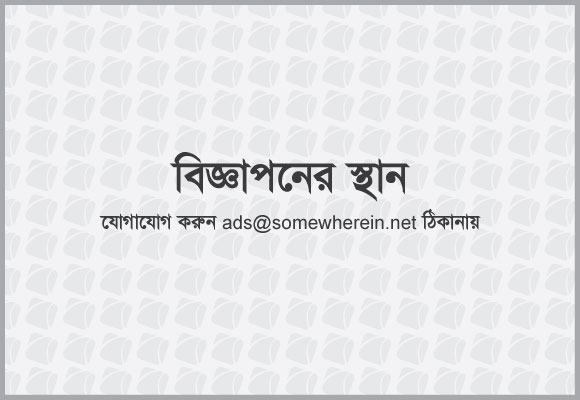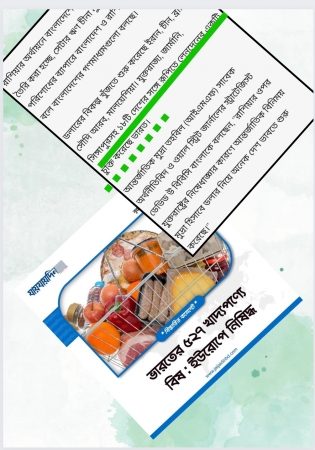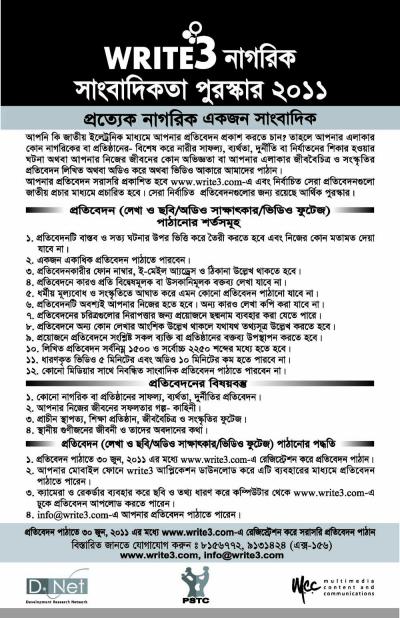আপনি জেনে খুশি হবেন যে, নাগরিক সাংবাদিকতার ধারণা, স্বরূপ-প্রকৃতি অর্থাৎ প্রত্যেক নাগরিকই একজন সাংবাদিক এই বিষয়টি ব্যাপকভাবে গণমানুষের মাঝে নিয়ে যাওয়ার লক্ষ্যকে সামনে রেখে ডিনেট (D.Net), পিএসটিসি (PSTC) ও এমসিসি (MCC) যৌথ উদ্যোগে “write3 নাগরিক সাংবাদিকতা পুরস্কার ২০১১”-প্রতিযোগিতার আয়োজন করেছে। ৩০ জুন ২০১১-এর মধ্যে প্রতিবেদন পাঠাতে হবে। পুরুস্কার বিতরণী অনুষ্ঠান সেপ্টেম্বর ২০১১। যত দ্রুত সম্ভব প্রতিবেদন জমাদিন।
প্রতিবেদন পাঠানোর গাইডলাইন
আপনি যে লেখা পাঠাবেন তাতে মূল বিষয়বস্তুর সাথে আবেগ, ভালোবাসা ঘৃণা, বিস্ময়, ক্ষোভ, ক্রোধ, বেদনা, কৌতুহল, শঙ্কা ইত্যাদি থাকবে। কী, কেন, কে, কখন, কোথায়, কীভাবে ইত্যাদি প্রশ্নের উত্তর থাকবে আপনার লেখায়। তবে এগুলো লেখার যে কোনো জায়গায় রাখলেই চলবে।
লেখার বিষয় কোথায় খুঁজবেন--
সবখানে খুঁজবেন। পুলিশ স্টেশন, লঞ্চঘাট, বাস টার্মিনাল, থিয়েটার, যাদুঘর, পাশের বাড়ি, স্কুল। গ্রামের সালিশ, হাসপাতাল। মাছের বাজার। সবখানেই আপনার লেখার বিষয় থাকতে পারে।
উদাহরণ
ধরা যাক, ঢাকা থেকে বরযাত্রী যাচ্ছে ফরিদপুরের ভাঙ্গায়। আজ রাতেই বিয়ে। বরের নাম সত্যজিৎ। দুটো মাইক্রোবাসে বরযাত্রী দল। ওদিকে ভাঙ্গায় মেয়ের বাড়িতে চলছে নানা রকম আয়োজন। বড় বড় মাছ কেনা হয়েছে, সবজি কোটা চলছে। কাঠ কিনে আনা হয়েছে রান্না-বান্নার জন্য। কিন্তু বরের গাড়ি ফরিদপুরের কাছাকাছি পৌঁছাতেই সামনে থেকে একটা বাস এসে একেবারে গুড়িয়ে দিল মাইক্রোবাসটিকে।
এরপর যা হয়। বরের লাশ পৌঁছুলো ভাঙ্গায়। যে কাঠ দিয়ে রান্না হওয়ার কথা ছিল, তা হয়ে গেল চিতার কাঠ।
এরকম মানবিক আবেগ থাকবে আপনার লেখায়।
লেখাটি হতে পারে নানা রকম। যেমন-
১. মানবিক আবেদন বা প্রেক্ষাপট
২. ব্যক্তিত্ব চিত্রণ।
৩. আত্মকথা বিষয়ক।
৪. স্বীকারোক্তিমূলক ।
৫. ইতিহাসভিত্তিক।
৬.সাক্ষাৎকারমূলক।
লেখাটি হতে হবে সাবলীল ভাষায় । প্রতিটি তথ্যই হবে সত্য, কিন্তু লেখা চলবে গল্পের আকারে। একটি ছোট গল্প আর আপনার লেখার মধ্যে পার্থক্য শুধু কল্পনা ও সত্যের মধ্যে, আর কিছু নয়। পাঠকের হৃদয় ছুঁয়ে যাওয়া ভাষায় লিখতে হবে।
কীভাবে লিখবেন
আপনার লেখার থাকবে তিনটি অংশ। সূচনা। অবয়ব। উপসংহার।
সংগৃহিত তথ্যই ঠিক করবে এর অবয়ব কী হবে।
লিখতে হবে ছোট ছোট বাক্য। একই শব্দের পুনরাবৃত্তি এড়াতে হবে। টেকনিক্যাল শব্দ এড়িয়ে চলতে হবে। সহজ ও সরল ভাষায় সরাসরি বলতে হবে। একটি বিষয়কে কেন্দ্র করেই আপানর লেখাটি আবর্তিত হবে, তার থেকে বেশি দূরে যাওয়া যাবে না।
উপসংহার হবে বেগবান। ছোটগল্পের মতো। শুরু ও শেষের মধ্যে একটা সম্পর্ক থাকতে হবে।
কয়েকরকম সূচনা
ভ্রমণবৃত্তান্তমূলক: ‘লোকটি সিড়ি বেয়ে নামছিল। নিচে কয়েকজন লোক ওর দিকে রক্তচক্ষু মেলে তাকিয়েছিল। সে তাদের দিকে তাকালো। থমকে দাঁড়ালো। চোখে-মুখে ভেসে উঠল উদ্বেগের ছায়া। কিছু একটা বলতে চাইল সে। ঠোঁটজোড়া নড়ে উঠল। ঠিক এই সময়ে গুলির আওয়াজ শোনা গেল। লোকটা আর্তনাদ করে উঠল।’
উদ্ধৃতি সূচনা: ‘বিশ্বে যা কিছু মহান সৃষ্টি, চিরকল্যাণকর/অর্ধেক তার গড়িয়াছে নারী অর্ধেক তার নর।’
স্ট্যাকাটো সূচনা: ছোট ছোট বাক্য। ‘আমি নিশ্চিত। পুরোপুরি নিশ্চিত। ছেলেমেয়েদের টিকা দেয়া হয়েছে। ওরা আর ছয়টি প্রাণঘাতী রোগে আক্রান্ত হবে না।’
প্রশ্ন সূচনা: ‘আপনার শিশুকে টিকা দেওয়া কতোটা দরকার তা আপনি জানেন কি?’
ছবি সূচনা: ‘নিঃশব্দ রাত। সূচ পড়লেও যেন শোনা যায়। সেই অন্তহীন নৈঃশব্দের বুক চিরে একটি কণ্ঠ ভেসে এলো, দরজা খুলুন, টেলিগ্রাম স্যার।’
বৈসাদৃশ্য সূচনা: পার্থক্য দেখিয়ে দেওয়া।: ‘চারবছর আগে ছিল জলাশয়। জেলেরা মাছ ধরত। এখন অসংখ্য ফ্ল্যাট। খেলার মাঠ। গাড়ি রিকশা।’
এমনভাবে লেখাটি লিখুন যেন আপনার লেখা পড়ে মানুষের কোমল মন আরো বেশি কোমল হয়ে যায়।
জাহীদ রেজা নূর
প্রথম আলো
অডিও গাইডলাইন
শুরুতে করণীয় (টেকনিক্যাল বিষয়)
অডিও ধারণযন্ত্র বা রেকডার ঠিক আছে কি আাছে কিনা লক্ষ্য করা। একধিক ক্যাসেট রাখার ব্যবস্থা করা। সেলফোনে রেকড করার ক্ষেত্রে মেমোরিকার্ড যথাযথ আছে কিনা এবং তাতে পর্যাপ্ত জায়গা আছে কিনা তা লক্ষ্য করা। সেলফোন থেকে কম্পিউটারে ফাইল ট্রান্সফার করার সময়ে কর্ড ঠিক আছে কিনা তা পরীক্ষা করে নেওয়া।
গোড়ার পরিকল্পনা
কোন বিষয়ে প্রতিবেদন করবেন তা নির্ধারণ করা। বিষয় নির্বাচনের ক্ষেত্রে মনে রাখতে হবে বিষয়টির উপযোগিতা সামাজিকভাবে কতটুকু? ব্যক্তি পর্যায়ে বিষয় হলে—সে কাজের মাধ্যমে সমাজের বা মানুষের উপকারীতা কি? অন্যদের উদ্বুদ্ধকরণে সহায়ক হবে কিনা এসব বিষয় পূর্ব থেকেই চিহ্নিত করতে হবে।
প্রশ্নমালা তৈরী করা
ব্যক্তি হলে ব্যক্তির সাক্ষাৎকার গ্রহণ। এলাকা হলে এলাকাবাসির সাথে কথা বলা / সাক্ষাৎকার গ্রহণ। এজন্য প্রশ্নমালা তৈরী করা।
প্রশ্নমালার ধরন নিম্নরূপ হতে পারে
ব্যক্তির নাম, পিতা-মাতার নাম, ঠিকানা, তার শৈশব-কৈশর-যৌবন ও তার কাজ নিয়ে প্রশ্ন করা যেতে পারে। কিভাবে কাজে নিয়োজিত হলেন? কিভাবে সাফল্য পেলেন? একাজে কারা বা কে কে আপনাকে সহযোগিতা করেছে? কেউ কি অসযোগিতা করেছে? একাজে অন্যদের কিভাবে সম্পৃক্ত করলেন? এই কাজের মাধ্যমে কে লাভবান হচ্ছে? আপনার ভবিষৎ পরিকল্পনা কি?
সমস্যার ক্ষেত্র প্রশ্নের ধরন নিম্নরূপ হতে পারে
ঘটনার স্থান, পরিবেশ, ঘটনার বর্ণনা। ঘটনার সাথে কে কে বা ক’জন জড়িত? ঘটনার পিছনে কি বা কোন কোন কারণ রয়েছে? থাকলে তার কি কি কারণ? কারো ইন্ধন আছে কিনা? এলাকার গণ্যমান্য ব্যক্তিদের প্রতিক্রিয়া? প্রশাসনের কর্তাব্যক্তিদের অবস্থান কি? আইন-শৃঙ্খলা রক্ষাকারী ব্যক্তিদের অবস্থান কি?
জাহিদ মুস্তফা
সিনিয়র শিল্প-নির্দেশক
বাংলাদেশ টেলিভিশন
Guideline for Video
Planning is the most important step before shooting anything. For general camera work, you can divide your plan into two parts: The "Shoot Plan" and the "Shot Plan".
Shoot Plan
In this case, the word shoot refers to a shooting session. If you think of everything you record as being part of a shoot, and have a plan for every shoot, then you're well on the way to having better organised footage.
Planning means adopting an attitude in which you take control. When you get out your video camera, instead of thinking "This will look good on video" and starting to shoot whatever happens, think "What do I want this to look like on video?". You then shoot (and if necessary, direct) the action to achieve your goal.
Plan the approximate length of the shoot: How much footage do you need to end up with, and how long will it take you to get it?
Planning to Edit
This is critical. If you think that this doesn't apply to you, then you're wrong. Everything you capture must be shot with editing in mind. There are two basic ways to edit: Post-production and in-camera.
Post-production (or just "post") editing means taking the shots you've recorded and re-assembling them later using editing equipment. This is how the professionals work — it gives you much greater flexibility when you're shooting and much better finished results. To do simple post editing, all you need is your camera, a VCR, and a few connecting leads. What it means for your shooting plan is that you can collect your shots in any order, and you can get as many shots as you like. At the editing stage, you discard unwanted shots and assemble the good ones however you like. This can be a time-consuming task (especially if you don't have much editing gear), but it's usually worth the effort.
In-Camera editing simply means that what you shoot is what you get — there is no post-production. The point here is that you're still editing. You still must decide which shot goes where, and which shots you don't need at all. The difference is that you're making these edit decisions as you shoot, rather than in post. This isn't easy, and it isn't possible to get it right all of the time. It requires planning, foresight, and experience.
Shot Plan
Once you have a plan for your shooting session, you're ready to begin planning individual shots.
First of all, have a reason for every shot. Ask yourself: "What am I trying to achieve with this shot? Is this shot even necessary? Have I already got a shot that's essentially the same as this one? Is my audience going to care about this subject?"
Once you're happy that you have a good reason to get the shot, think about the best way to get it. Consider different angles, framing, etc. The art of good composition takes time to master but with practice you will get there.
Ask yourself exactly what information you wish to convey to your audience through this shot, and make sure you capture it in a way that they will understand.
Take the time to get each shot right, especially if it's an important one. If necessary (and if you're editing in post), get a few different versions of the shot so you can choose the best one later.
Shooting Technique
Steps for shooting :
1. Position yourself and your camera.
2. Frame your shot.
3. Think about your audio.
4. Press "record"
5. Keep checking the status displays
6. Use both eyes.
7. Learn to walk backwards.
8. Keep thinking "Framing...Audio..."
9. Press "record stop" before moving.
Here's a few more tips to finish the work :...
1. Be diplomatic while shooting. Think about the people you're shooting. Remember that people are often uncomfortable about being filmed, so try to be diplomatic in taking shots.
2. Use the "date/time stamp" feature sparingly. It's unnecessary to have the time and date displayed throughout your video, and it looks cheap. If you must have it there, bring it up for a few seconds, then get rid of it. Modern digital cameras have the ability to show or hide this display at any time after recording.
Framing
Shots are all about composition. Rather than pointing the camera at the subject, you need to compose an image. Framing is the process of creating composition.
Some Rules of Framing
• Look for horizontal and vertical lines in the frame (e.g. the horizon, poles, etc). Make sure the horizontals are level, and the verticals are straight up and down (unless of course you're purposely going for a tilted effect).
• "Headroom", "looking room", and "leading room". These terms refer to the amount of room in the frame which is strategically left empty. The shot of the baby crawling has some leading room for him to crawl into, and the shot of his mother has some looking room for her to look into. Without this empty space, the framing will look uncomfortable.
• Headroom is the amount of space between the top of the subject's head and the top of the frame. A common mistake in amateur video is to have far too much headroom, which doesn't look good and wastes frame space. In any "person shot" tighter than a MS, there should be very little headroom.
• Everything in your frame is important, not just the subject. What does the background look like? What's the lighting like? Is there anything in the frame which is going to be distracting, or disrupt the continuity of the video?
Pay attention to the edges of your frame. Avoid having half objects in frame, especially people (showing half of someone's face is very unflattering). Also try not to cut people of at the joints — the bottom of the frame can cut across a person's stomach, but not their knees. It just doesn't look right.
Basic shot types
Basic shots are referred to in terms relative to the subject. For example, a "close up" has to be a close up of something. A close up of a person could also be described as a wide shot of a face, or a very wide shot of a nose.
EWS (Extreme Wide Shot) - In the EWS, the view is so far from the subject, isn't even visible. The point of this shot is to show the subject's surroundings. The EWS is often used as an establishing shot — the first shot of a new scene, designed to show the audience where the action is taking place.
VWS (Very Wide Shot) - The VWS is much closer to the subject. It is (just) visible here, but the emphasis is still on placing it in it’s environment. This also works as an establishing shot.
WS (Wide Shot) - In the WS, the subject takes up the full frame. In this case, the subject's feet are almost at the bottom of frame, and it’s head is almost at the top. Obviously the subject doesn't take up the whole width of the frame, since this is as close as we can get without losing any part of it. The small amount of room above and below the subject can be thought of as safety room — you don't want to be cutting the top of the head off. It would also look uncomfortable if the feet and head were exactly at the top and bottom of frame.
MS (Mid Shot) - The MS shows some part of the subject in more detail, whilst still showing enough for the audience to feel as if they were looking at the whole subject. In fact, this is an approximation of how you would see a person "in the flesh" if you were having a casual conversation. You wouldn't be paying any attention to their lower body, so that part of the picture is unnecessary.
MCU (Medium Close Up) - Half way between a MS and a CU. This shot shows the face more clearly, without getting uncomfortably close.
CU (Close Up) - In the CU, a certain feature or part of the subject takes up the whole frame. A close up of a person usually means a close up of their face.
ECU (Extreme Close Up) - The ECU gets right in and shows extreme detail. For people, the ECU is used to convey emotion.
CA (Cutaway) - A cutaway is a shot that's usually of something other than the current action. It could be a different subject, a CU of a different part of the subject, or just about anything else. The CA is used as a "buffer" between shots (to help the editing process), or to add interest/information.
Once you're comfortable with the do's and don'ts, you can become more creative. Think about the best way to convey the meaning of the shot. If it's a baby crawling, get down on the floor and see it from a baby's point-of-view (POV). If it's a football game, maybe you need to get up high to see all the action.
Look for interesting and unusual shots. Most of your shots will probably be quite "straight"; that is, normal shots from approximate adult eye-level. Try mixing in a few variations. Different angles and different camera positions can make all the difference. For example; a shot can become much more dramatic if shot from a low point. On the other hand, a new and interesting perspective can be obtained by looking straight down on the scene. Be aware that looking up at a person can make them appear more imposing, whereas looking down at a person can diminish them.
Watch TV and movies, and notice the shots which stand out. There's a reason why they stand out — it's all about camera positioning and frame composition. Experiment all the time.
Source : http://www.mediacollege.com
write3 নাগরিক সাংবাদিকতা পুরস্কার ২০১১-এর প্রতিবেদন পাঠানোর সময় বাড়লো ৩০ জুন ২০১১ পর্যন্ত
এই পোস্টটি শেয়ার করতে চাইলে :
Tweet
২টি মন্তব্য ০টি উত্তর

আলোচিত ব্লগ
ধর্ম ও বিজ্ঞান
করোনার (COVID) শুরুর দিকে আমি দেশবাসীর কাছে উদাত্ত আহবান জানিয়ে একটা পোস্ট দিয়েছিলাম, যা শেয়ার হয়েছিল প্রায় ৩ হাজারবার। জীবন বাঁচাতে মরিয়া পাঠকবৃন্দ আশা করেছিলেন এ পোস্ট শেয়ারে কেউ একজন... ...বাকিটুকু পড়ুন
তালগোল

তুমি যাও চলে
আমি যাই গলে
চলে যায় ঋতু, শীত গ্রীষ্ম বর্ষা
রাত ফুরালেই দিনের আলোয় ফর্সা
ঘুরেঘুরে ফিরেতো আসে, আসেতো ফিরে
তুমি চলে যাও, তুমি চলে যাও, আমাকে ঘিরে
জড়ায়ে মোহ বাতাসে মদির ঘ্রাণ,... ...বাকিটুকু পড়ুন
মা

মায়াবী রাতের চাঁদনী আলো
কিছুই যে আর লাগে না ভালো,
হারিয়ে গেছে মনের আলো
আধার ঘেরা এই মনটা কালো,
মা যেদিন তুই চলে গেলি , আমায় রেখে ওই অন্য পারে।
অন্য... ...বাকিটুকু পড়ুন
কপি করা পোস্ট নিজের নামে চালিয়েও অস্বীকার করলো ব্লগার গেছে দাদা।

একটা পোস্ট সামাজিক যোগাযোগ মাধ্যমে বেশ আগে থেকেই ঘুরে বেড়াচ্ছে। পোস্টটিতে মদ্য পান নিয়ে কবি মির্জা গালিব, কবি আল্লামা ইকবাল, কবি আহমদ ফারাজ, কবি ওয়াসি এবং কবি... ...বাকিটুকু পড়ুন
ভারতকে জানতে হবে কোথায় তার থামতে হবে

ইন্ডিয়াকে স্বপ্ন দেখানো ব্যাক্তিটি একজন মুসলমান এবং উদার চিন্তার ব্যাক্তি তিনি হলেন এপিজে আবুল কালাম। সেই স্বপ্নের উপর ভর করে দেশটি এত বেপরোয়া হবে কেউ চিন্তা করেনি। উনি দেখিয়েছেন ভারত... ...বাকিটুকু পড়ুন


 অনুগ্রহ করে অপেক্ষা করুন। ছবি আটো ইন্সার্ট হবে।
অনুগ্রহ করে অপেক্ষা করুন। ছবি আটো ইন্সার্ট হবে।.jpg)



